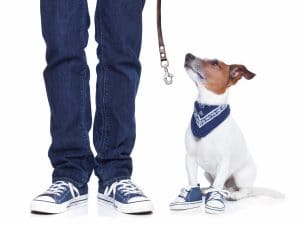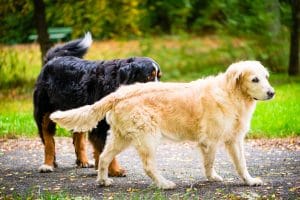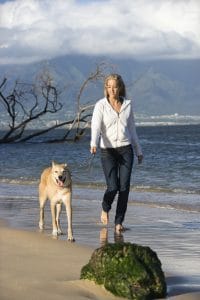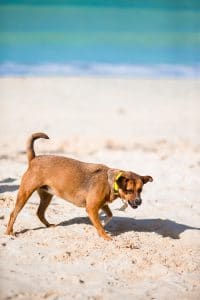![]()
HeelBoyHeel is reader supported. When you buy through any link on our site, we may earn an affiliate commission, but never at any extra cost to you.

Developing good habits in your puppy from day one is important, especially if you want to avoid your puppy developing bad habits! By about four months of age, a puppy will become more independent, so make the most of the early months to set boundaries, for example if you don’t want a fully grown German Shepherd sitting on the sofa to watch T.V. with you, don’t let the small, fluffy version do it either.
This is also the best time to teach your puppy basic commands. The time you put in early on training your puppy will pay dividends later. Remember, it will be far harder to correct bad behavior in the future.
If you are adopting an older dog, you will still want him or her to be well behaved. This may take a little longer but it is achievable. You may wish to take advantage of training classes to help with any unwanted behavior that your dog may have developed before coming to live with you.
Below are some positive habits that will benefit both you and your dog, so that both of you have a more fulfilling relationship.
1. Obeying Your Commands
In order to obey, you first have to understand what you are being asked to do. This is exactly the same for a puppy or dog and your new hound is trying to understand what is expected from him or her in a foreign language! Make sure you have your dog’s full attention when learning a new command. Most dogs enjoy learning something new, especially when learnt through play or an activity they enjoy.
By being consistent and patient with your puppy or dog, he or she will soon learn to understand and obey basic commands, such as “Sit”, “Stay”, “Come”, “Heel”, “No”, “Leave” and “Down”. There are various training methods you can use to help with this but please remember that positive reinforcement always works best. To start with, reward your dog with lots of fuss and a dog treat when he or she has even a partial success. After a while your dog will be happy to obey commands and it will become a normal part of his or her life.
The learning process will help to build a strong bond between you and your dog or pup on which to build your relationship.
2. Dog Hygiene

A dog’s idea of hygiene and yours will probably not be quite the same! A dog in the wild will maintain a certain standard of hygiene appropriate to his or her living conditions. They will not be offended by another dog who is a little on the “whiffy” side.
However, your new dog or puppy has come to live with you and you will expect certain standards. Muddy paws can be restricted to an area of the house with a solid floor that can be cleaned easily but surely it is better to be able to clean the offending paws.
So, the best solution is to get your new friend into the habit of basic hygiene procedures from the start. This can be achieved by lots of physical contact, starting with stroking and progressing to a soft brush. This should be enjoyable for your dog but if he or she is upset or shows signs of stress, stop and start again another time.
Muddy paws can be sorted out with a bowl of tepid water, some dog shampoo and an old towel or two. If or when you have to give your dog a bath, the same applies but try to avoid getting water in your dog’s eyes. You can sort out the face with a soft, damp flannel. Don’t be surprised when your soggy hound has a jolly good shake to get dry. Another point to be aware of is that a damp dog will enjoy a good roll in some dry mud after a bath, (or something more pungent, if available), so keep the door shut!
3. Socialize Your Dog Or Puppy

In order that you can have a social life, it is important that your dog or puppy is social as well. As with people, some dogs and puppies are more social than others.
Your dog or puppy will be looking to you for a lead in this. If he or she sees that you are happy and confident in a new social situation, most dogs will follow your lead. By introducing your puppy or dog to a variety of people, he or she will learn to relax with strangers. Other pet owners are great for this, as they will more than likely make a fuss of your dog and your dog has a chance to get to know and sniff their dog!
If your older dog is nervous in social situations, this may result in aggressive behavior. This is when it is a good idea to look for some proper training. This will give your dog the opportunity to learn new skills while being surrounded by other dogs and people. A professional dog trainer will be able to give you advice on what will be the most appropriate setting for your dog and you.
4. Patient And Calm
Patient and calm is what you need to be if this is how you want your dog to be. An excitable puppy may be fun and entertaining, however an excitable fully grown dog crashing round the house will not be funny at all.
Once again, start as you mean to go on from day one. When your puppy or dog gets out of control, don’t escalate the situation by joining in with the hysteria. This will only enforce your dog’s idea that this is acceptable behavior. Wait patiently for your dog to calm down and then reward the calm behavior you want your dog to achieve.
5. Keep Up Timing
Dogs and puppies have selective memories! They may quickly learn and remember where their food and treats live, or what is going to happen when the leash is produced.
However, when it comes to learning good habits, rewarding desired behavior has to be immediate. By the time you have gone to get a dog treat from indoors, your dog or puppy will be on to the next interesting thing to investigate and the moment is lost. The same applies for correcting unwanted behavior. “What did you do that for?” 10 minutes after the event will definitely confuse your dog.
6. Good Leash Habits

Who’s taking who for a walk? And it has to be you in control! Even if you have a small dog, it makes a walk far less enjoyable if you are constantly being pulled one way and another.
To start off with, ensure you have the right equipment. A harness, opposed to your dog’s collar, is preferably to attach the leash to, especially for young pups and small dogs.
Your dog or puppy should learn to walk on your left hand side. Walk quickly, reassuring your dog as you go. When he or she pulls, stop. If you keep on walking your dog will assume that it is OK to pull. Once again, lots of praise and a treat for good behavior. This may sound easy but it takes a lot of patience and time to achieve good leash habits. If you are not having much success with this, try attending a few training sessions. A good trainer will be able to suggest other tips to try.
Remember that the daily walk will be one of the highlights of your dog’s day. So, if he or she wants to stop to sniff an interesting smell or say “hello” to another dog, respect his or her wishes, within reason.
7. Avoid Unnecessary Barking

A young puppy or dog will probably not bark when first coming to live with you. Before you congratulate yourself on your good fortune, be aware that initially your dog will be figuring out his or her new home. As your dog’s confidence develops in his or her new surroundings, so will the “woof”.
Once again, the initial yaps of a young puppy may be cute and amusing but now is the time to stop unwanted barking.
Your dog is trying to tell you something and with time you will learn to understand what that is. It may be as simple as standing by the door and attracting your attention with a single bark to let you know it is time to go outside, or excited barking to remind you that he or she wants to be included in a family outing. As your dog becomes more protective of you, your family and his or her new home, you can forget the doorbell when a stranger comes to the door.
You may decide that some of these reasons to bark are positive. However, if your dog consistently barks at passers by and it is wearing you and your neighbours down, for example, it is time to take charge before your dog assumes that this behavior is acceptable. Don’t join in with the barking, instead choose a behavior that you are happy for your dog to do instead. Gain your dog’s attention and ask him or her to “sit” for example, and then reward the habit you want your dog to achieve. Or remove the trigger that starts the barking, for example, don’t leave your dog in a position where he or she can see passers by. You cannot remove the passers by!
8. Good Habits Outdoors
For your dog or puppies’ own safety, and your bank balance, he or she needs to learn a few good habits when outdoors.
One of the first lessons your dog needs to learn, is to come when called. If you have a secure outside area, you can start to teach your dog off the leash. Try incorporating the lesson in a game. Throw one of your dog’s toys for him or her to chase after, then squat down to your dog’s level and give the command “Come” with a friendly, enthusiastic voice. No dog is going to run towards a shouting, angry voice. Every time this is successful, be sure to reward your dog with lots of praise and a dog treat.
If you do not have a suitable safe area, you will need to use a long leash. No need to throw a toy this time! Squat down, give the command and gently pull the leash to encourage your dog to come to you. Once again, lots of praise and a treat.
Another important lesson for your dog are “Leave” and “Drop”. Dogs and puppies love to investigate something smelly, the smellier the better and after a good sniff, the next course of investigation is to pick it up in their mouth. However, something smelly may include rotten food, for example, and if ingested the next stop may be the vets.
One way to teach your dog these commands is to place one dog treat in both of your hands. Let your dog sniff the enclosed treat, then transfer the treat to one hand and put it behind your back. Show your dog the hand without the treat, with the command “Leave”. When your dog has stopped attempting to get the treat from your empty hand, reward him or her with the treat from your other hand.
9. Healthy Eating Habits
Food is an important part of your dog’s day. However, this is when, as with people, manners are important. If not handled correctly from day one, feeding time can become chaotic!
This is when your own personal situation dictates how you tackle it. If you only have the one dog or pup, you may decide to leave dry food in a bowl, so your dog can help himself or herself when they wish. If you have more than one dog, feeding time has to be more controlled.
Before putting a bowl of food on the floor, ask your dog to sit and wait and then you can let your dog know that he or she has permission to eat. Don’t reward your dog with a bowl of food if he or she is jumping up and down, running round in circles or barking. Don’t include small children in the food time routine as your dog may be very protective over the food and see the child as a threat.
All food is interesting to dogs and this includes human food especially. Do not get into the habit of sharing your food with your new friend as this will lead to your dog believing that your food is his or her food, and before long you will not only have a dog but a thief in the house.
Conclusion
Bad habits are difficult to break! Although it will take time, patience and consistency to instil good habits in your new puppy or dog, it will reward both of you with a stronger more enjoyable relationship.
Initially concentrate on the positive habits that you and your family members will benefit from most while working on not encouraging bad habits. If you are struggling to achieve certain habits, especially with an older dog, don’t feel as if you are failing by seeking help from training classes. You will both benefit from them.
Like children and people, dogs learn at their own speed and certain habits will be easier than others. After all, all dogs have a personality and it is your job to help them develop this personality and bring out the best aspects.
And above all, remember to have fun (both of you)!